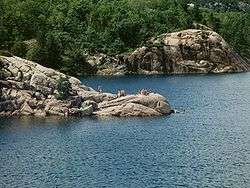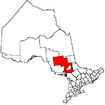Killarney, Ontario
| Killarney | |
|---|---|
| Municipality (single-tier) | |
| Municipality of Killarney | |
|
George Lake in Killarney | |
|
| |
| Coordinates: 45°59′N 81°31′W / 45.983°N 81.517°WCoordinates: 45°59′N 81°31′W / 45.983°N 81.517°W | |
| Country |
|
| Province |
|
| District | Sudbury |
| Incorporated | January 1, 1999 |
| Government | |
| • Type | Town |
| • Mayor | Ginny Rook |
| • Governing Body | Killarney Municipal Council |
| • MP | Marc Serré (Liberal) |
| • MPP | France Gélinas (NDP) |
| Area[1] | |
| • Land | 1,654.58 km2 (638.84 sq mi) |
| Population (2011)[1] | |
| • Total | 505 |
| • Density | 0.3/km2 (0.8/sq mi) |
| Time zone | EST (UTC-5) |
| • Summer (DST) | EDT (UTC-4) |
| Area code(s) | 705 |
| Website | Municipality of Killarney |
Killarney is a municipality located on the northern shore of Georgian Bay in the Sudbury District of Ontario, Canada. Killarney is commonly associated with Killarney Provincial Park, which is a large wilderness park located to the east of the townsite which occupies much of the municipality's expanded boundary.
In addition to the community of Killarney itself, the communities of Hartley Bay and Bigwood, and the ghost towns of French River, Collins Inlet and Key Harbour, are also located within the municipal boundaries.
The eastern end of the La Cloche Mountain Range is also located within the municipality of Killarney.
History
The area was named after the town of Killarney in Ireland.
The area was first settled in 1820 by French Canadian fur trader Étienne Augustin de Lamorandière and his Anishinaabe wife Josephte Saisaigonokwe, who established a trading post named Shebahonaning (canoe passage) at the townsite.
Killarney was operated as a fishing camp by the Fruehauf Trailer Company in Detroit, Michigan. Roy Fruehauf, president of the company from 1949 to 1961, was primarily responsible for operating Killarney. Clients and guests would be flown in via Mallard Sea Planes for vacations during the warmer summer months.
Highway 637, connecting Killarney to Highway 69, was constructed in 1962.[2] Prior to its construction, the community relied primarily on water transport via Georgian Bay and the North Channel.
The current municipality was incorporated on January 1, 1999, when the Ontario provincial government expanded the boundaries of the township of Rutherford and George Island, the former governing body of the community of Killarney. The municipality was also transferred from the Manitoulin District to the Sudbury District at that time. In 2006, the municipality was enlarged again when it annexed the unorganized mainland portion of Manitoulin District.[3]
The larger municipality of Killarney now encompasses virtually all of Killarney Provincial Park and the French River delta, and in fact extends all the way to Highway 69, over 70 kilometres from the townsite. Despite the municipality's geographic size, however, most of its population continues to reside in the community of Killarney itself, although smaller settlements also exist at Hartley Bay and Bigwood.
Townships
The municipal boundaries of Killarney encompass the geographic townships of Rutherford and George Island, Hansen, Goschen, Sale, Attlee, Kilpatrick, Travers, Struthers, Allen, Bigwood, Killarney, Humboldt and Carlyle, and the northern part of Henvey.
The township of Hansen was originally named Stalin after Joseph Stalin, but was renamed in 1986 when Ontario MPP Yuri Shymko successfully had a private member's bill passed through the Legislative Assembly of Ontario to rename the township in honour of athlete Rick Hansen, who was in the midst of his international Man in Motion tour at the time.[4]
Economy
The Killarney area's economy is based primarily on tourism, consisting mainly of wilderness lodges, campgrounds and retail services geared toward campers and other visitors to Killarney Provincial Park.
A community museum, the Killarney Centennial Museum, is located in Killarney adjacent to the municipal government offices.
Although not officially part of the Sudbury East region, Killarney participates in the regional Sudbury East Planning Board with the municipalities of French River, St. Charles and Markstay-Warren.
Killarney Provincial Park is also home to the Killarney Provincial Park Observatory.
Transportation
The primary road access to Killarney is via Highway 637. The town is also served by the small Killarney Airport. It is also possible to travel to Killarney by boat, usually from the town of Little Current.
Demographics
| Canada census – Killarney, Ontario community profile | |||
|---|---|---|---|
| 2011 | 2006 | 2001 | |
| Population: | 505 (10.0% from 2006) | 454 (6.1% from 2001) | 428 (-42.0% from 1996) |
| Land area: | 1,654.58 km2 (638.84 sq mi) | 1,513.58 km2 (584.40 sq mi) | 1,513.30 km2 (584.29 sq mi) |
| Population density: | 0.3/km2 (0.78/sq mi) | 0.3/km2 (0.78/sq mi) | 0.3/km2 (0.78/sq mi) |
| Median age: | 48.2 (M: 46.6, F: 49.1) | 47.3 (M: 46.9, F: 47.4) | |
| Total private dwellings: | 400 | 590 | 792 |
| Median household income: | $50,960 | $33,631 | |
| References: 2011[1] 2006[5] 2001[6] | |||
| Historical populations | ||
|---|---|---|
| Year | Pop. | ±% |
| 1996 | 738 | — |
| 2001 | 428 | −42.0% |
| 2006 | 454 | +6.1% |
| 2011 | 505 | +11.2% |
See also
References
- 1 2 3 "Killarney census profile". 2011 Census of Population. Statistics Canada. Retrieved 2012-02-22.
- ↑ Rainbow Country Travel Association
- ↑ "Annual changes to census subdivision codes, names and types, between 2006 and 2011, by province and territory, and by year". Standard Geographical Classification (SGC) 2011. Statistics Canada. Retrieved 2012-02-22.
- ↑ "Wheelchair hero circles the globe". The Free Lance-Star. Fredericksburg, Va. AP. 1986-11-08. Retrieved 28 May 2012.
- ↑ "2006 Community Profiles". Canada 2006 Census. Statistics Canada. March 30, 2011. Retrieved 2012-02-22.
- ↑ "2001 Community Profiles". Canada 2001 Census. Statistics Canada. February 17, 2012. Retrieved 2012-02-22.
External links
| Wikivoyage has a travel guide for Killarney (Ontario). |


